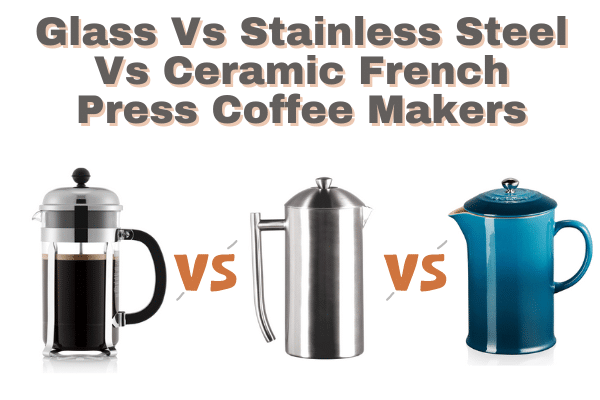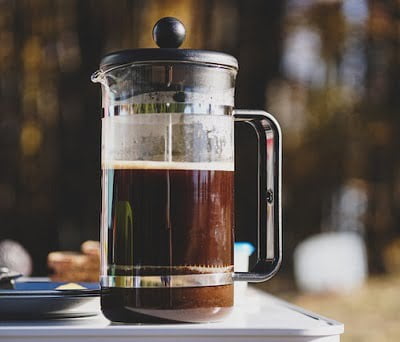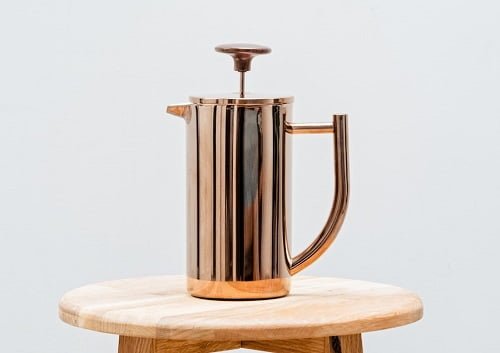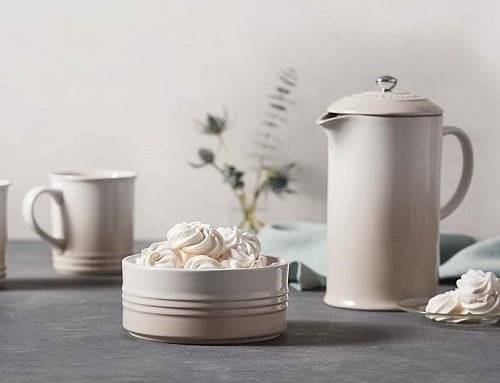Glass, stainless steel, or ceramic – which material makes the best French press? If you’re searching for the perfect balance of flavor, durability, and aesthetics in your French press, the battle of materials matters.
Key Takeaways
- Glass French presses are affordable, and a classic way to brew French Press Coffee.
- Stainless steel presses retain heat better and are best for traveling purposes.
- Ceramic French presses have exquisite designs, don’t retain tastes/odors, and are eco-friendly, but are expensive and heavy.

Although, all the materials can brew a perfect cup of French Press as long as the construction material is reliable and the filters are adequate. But there are some advantages and disadvantages of a certain material over the other.
In this article, I will discuss the pros and cons of Glass vs Stainless Steel vs Ceramic French Press. So, you can easily choose the right French Press that matches your needs.
Pros of Glass French Press
Glass French Presses are the most abundant ones as they are affordable and readily available.
Whenever I think of a French Press, the first thing that comes to my mind is a glass jar with a plunger assembly, and this might be the case with you.

The glass French Presses have the following benefits over the others:
- Glass French Presses are very affordable in price. You can find a perfectly good glass French Press for anywhere between $15 and $40. Sure, there are pricier models out there that offer better features and sturdier designs, but you can definitely get a decent one without breaking the bank.
- The best thing about Glass French Press is that you can visualize the brewing process. There’s something incredibly satisfying and alluring about seeing the coffee’s color change as it steeps. And if you’re the type who can tell when the coffee is ready just by looking at its shade, rather than strictly following steeping times, then a glass French Press is the perfect choice for you.
Cons of Glass French Press
I personally like glass French Press more than stainless steel ones because glass looks more classic and gives a more pleasurable taste experience.
But there are also some cons associated with glass French Press coffee makers.
- A disadvantage of the glass French Press is that it does not retain heat for very long. These glass brewers are well-suited if you plan to consume your coffee immediately after brewing. However, if you want to keep the coffee and enjoy it later in the day, a glass French Press will not be the ideal choice. In such cases, it’s advisable to transfer the coffee to an insulated mug to better preserve its temperature and flavors.
- The other disadvantage is obvious; the glass can shatter easily, and they are not as strong as the stainless steel ones. So, you have to take special care of them, and you can’t take them easily on camping trips.
Most good quality glass French Presses are made of borosilicate glass. Borosilicate glass is mechanically stronger than normal glass. And also, most of the good glass French Presses are encased in a metal housing, giving them additional strength.
My recommendation is never to buy a glass French Press cheaper than 17-20 dollars as they are often made with thin, fragile glass that can break easily and does not retain heat well.
Pros of Stainless-Steel French Press
Stainless steel French Press coffee makers are also very popular, and some people actually prefer to have metal French Press instead of glass or ceramic ones as it has the following benefits:

- Metal French Presses are very strong and sturdy, and you can’t easily break one easily. That’s why travelers and campers prefer to choose Stainless steel French Press as their travel partner instead of glass or ceramic ones. Moreover, metal French Presses are also very lightweight and portable.
- Stainless Steel French Press keeps the coffee hottest for a long period. Most Metal French presses have a double-walled design with an insulated layer inside which keeps the coffee hot for 2 hours.
If you live in an area where the temperature is low, you must preheat the Metal Carafe first. Otherwise, the temperature of the water will fall instantly when you pour in the boiling water, and the extraction of coffee grounds will not occur at the ideal brewing temperature.
Check out Espro P6 vs P7 – High Quality Metallic French Presses
Cons of Stainless-Steel French Press
Metal French Presses are strong and sturdy and can easily last for a lifetime, but there are also some cons of stainless-steel Cafetieres.
- Many coffee snobs complain that metal affects coffee taste, and I second that claim. Metal does introduce a subtle change in flavor, but if you’re not a very picky coffee lover who obsesses over every nuance of the coffee flavors, this issue is unlikely to be a significant concern. In my experience, most casual coffee drinkers cannot notice any noticeable difference in taste when using a metal French Press.
- With metal French Presses, you will miss the captivating visual experience of the brewing process. And also, you will have to measure the water before pouring it into the carafe. In most of the Glass French Presses, there are markings on the carafe for precise water filling. You will miss that feature in metal French Press coffee makes as the carafe is not see-through.
If you want to buy a Stainless-steel French Press, then you must choose an insulated one. You will find an excellent insulated French Press in the range of 30 to 50 dollars.
I have reviewed and prepared the list of Best insulated Metal French Press coffee makers. Make sure to check it out!
Pros Of Ceramic French Press
Ceramic French Presses are not quite common as they are very expensive and not very durable. They are only reserved for coffee lovers who appreciate both flavor and aesthetics.

The pros of Ceramic French Presses are:
- The best thing about Ceramic French Press is its exquisite design. These cafetières can add a stylish touch to your kitchen. A Ceramic Press is one of the perfect options if you’re going to gift a French Press to your loved ones, since it looks adorable and makes a great present.
- Ceramic material does not retain any taste or odor from the previous brew. That’s why coffee prepared with Ceramic Presses gives the most pleasurable experience. I have tried Le Creuset French Press, and I was surprised by the pleasant and smooth taste of the coffee. Ceramics do not react with any food acids or alkalis and hence remain best for a lifetime.
- The Ceramic material is completely eco-friendly and is a green alternative to other materials. There is not even a trace of heavy metals present in ceramics; this makes the ceramic French press the healthiest and most environmentally friendly choice.
Cons of Ceramic French Press
Ceramic French Presses look very adorable and they can indeed make a most pleasurable cup of coffee. There are also some cons:
- One significant drawback of ceramic French presses is their higher cost compared to glass and metal options. You’ll have to spend $80 or more to buy a quality ceramic model. They are also very heavy, so they are certainly not suitable for traveling purposes.
- Although Ceramic material is more reliable and stronger than glass French Press, it will definitely break if you drop it from the height of your kitchen counter. Even a small crack in Ceramic French Press will make it virtually unusable.
- Ceramic material retains heat for less time than insulated metal French Presses but certainly longer than a glass French Press.
What Material is Best for French Press?
I have mentioned all the pros and cons and Glass vs stainless steel vs Ceramic French Press coffee makers in detail.
In the end, I just want to make three points:
- If you are a design-conscious person and want the best from your cup, go with a Ceramic Press.
- If you often take your French Press for camping or on other trips, go with the stainless steel
- If you want a classic design at an affordable price without compromising the quality of coffee, go with a Glass French Press.
Related French Press Guides



